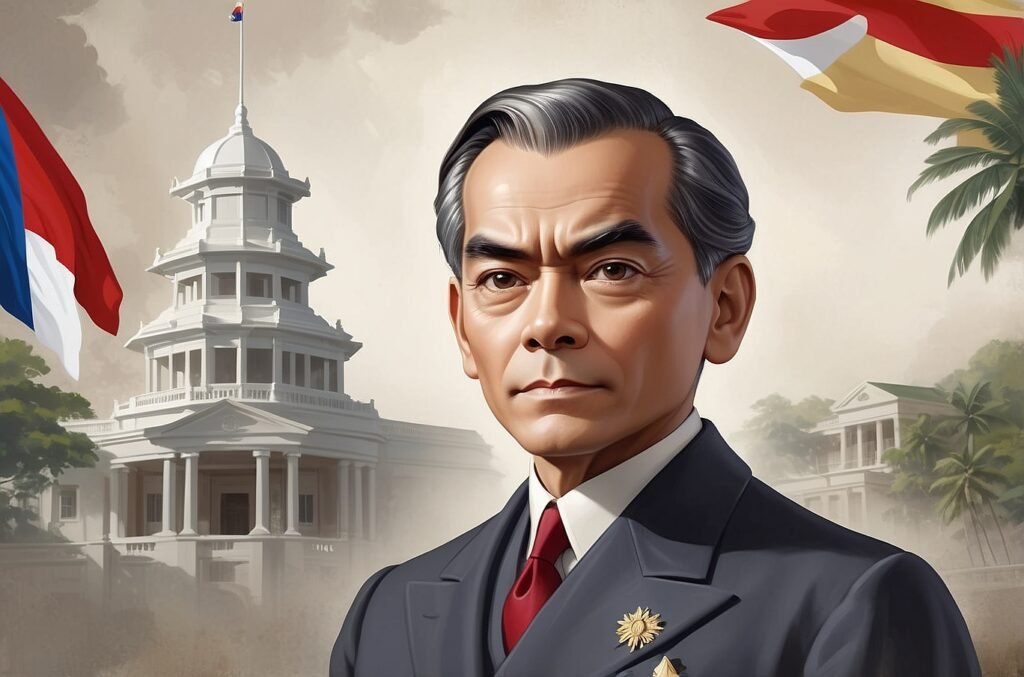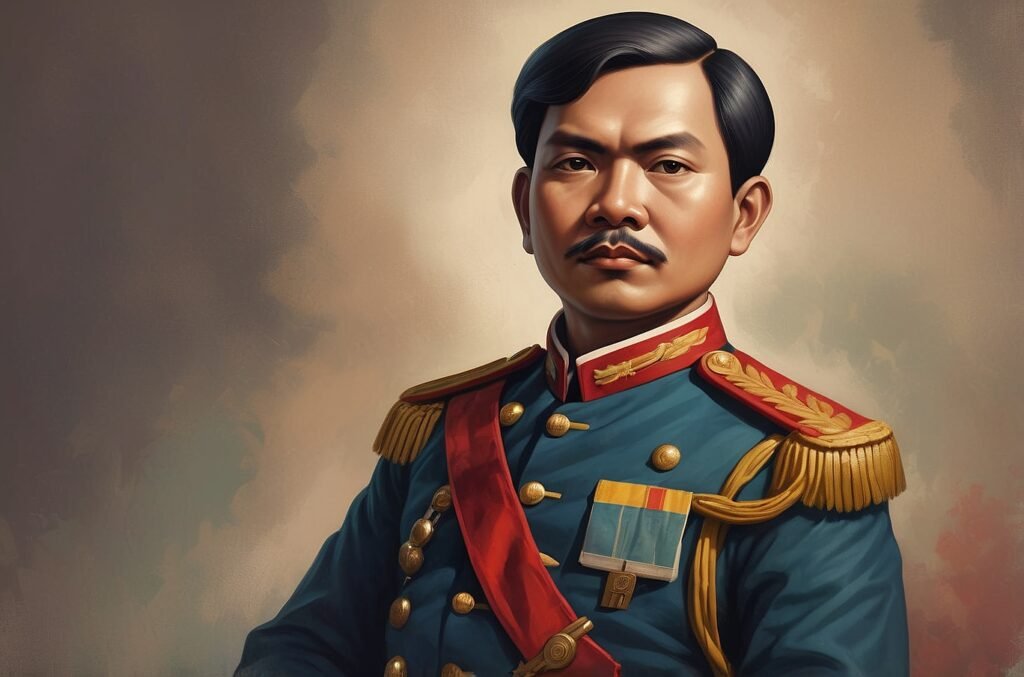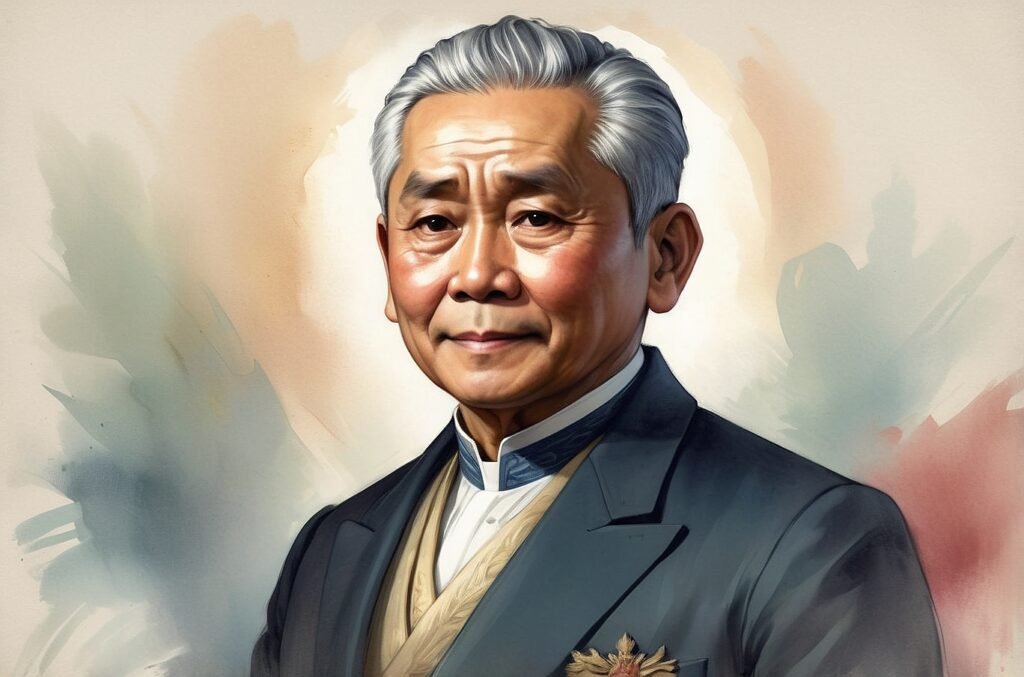Manuel Luis Quezon y Molina was born on August 19, 1878, in Baler, Tayabas (now Aurora province), Philippines. His parents, Lucio Quezon and Maria Dolores Molina, were both schoolteachers. Growing up in a small town, young Manuel was exposed to the realities of Spanish colonial rule and the growing desire for Philippine independence. His early education began in his hometown, where he showed promise as a diligent and intelligent student. As he progressed in his studies, Quezon’s ambition and intellect became increasingly apparent, setting the stage for his future political career.
In 1893, Quezon moved to Manila to continue his education at the Colegio de San Juan de Letran. It was here that he honed his academic skills and developed a deeper understanding of the social and political landscape of the Philippines under Spanish rule. His time at the prestigious institution not only broadened his intellectual horizons but also introduced him to influential figures who would later play significant roles in the country’s struggle for independence. After completing his studies at Colegio de San Juan de Letran, Quezon enrolled at the University of Santo Tomas to pursue a law degree, further solidifying his foundation for a future in politics and governance.
Academic Achievements
During his time at the University of Santo Tomas, Quezon distinguished himself as a brilliant law student. His academic prowess was evident in his consistent high marks and his ability to engage in complex legal discussions. This period of his life was crucial in shaping his understanding of jurisprudence and governance, which would later inform his political ideologies and leadership style. Quezon’s legal education provided him with the tools to navigate the intricate political landscape of the Philippines and to articulate his vision for the country’s future with clarity and conviction.
Military Service and Early Political Career
Following the outbreak of the Philippine-American War in 1899, Quezon joined the nationalist forces led by Emilio Aguinaldo. His participation in the war demonstrated his commitment to the cause of Philippine independence and his willingness to fight for his beliefs. Although the Filipino forces were ultimately defeated, Quezon’s experience in the military shaped his perspective on leadership and national defense, which would later influence his policies as president. After the war, he surrendered and took the oath of allegiance to the United States, a decision that would allow him to pursue a career in politics under the new colonial administration.
In 1906, Quezon was elected as the governor of Tayabas province, marking the beginning of his formal political career. His tenure as governor provided him with valuable experience in local governance and allowed him to build a strong political base. During this time, Quezon demonstrated his ability to balance the interests of his constituents with the demands of the American colonial administration. His success as a provincial governor catapulted him onto the national stage, paving the way for his ascent in Philippine politics.
Rise to National Prominence
Quezon’s political acumen and charisma quickly propelled him to national prominence. In 1907, he was elected as one of the two resident commissioners to the U.S. House of Representatives, representing the Philippines. This position allowed him to advocate for Philippine interests directly in Washington, D.C., and to build relationships with American politicians. During his tenure as resident commissioner, Quezon worked tirelessly to advance the cause of Philippine independence, using his diplomatic skills and legal expertise to argue for greater autonomy and eventual sovereignty for his country.
The Road to Independence
As Quezon’s influence grew, so did his role in shaping the future of the Philippines. He became a key figure in the push for independence, working within the American political system to advance Philippine interests. In 1916, Quezon played a crucial role in the passage of the Jones Law, which promised eventual independence for the Philippines and established a more autonomous government structure. This law was a significant step towards Philippine sovereignty and demonstrated Quezon’s effectiveness as a political negotiator.
Quezon’s efforts culminated in the passage of the Tydings-McDuffie Act in 1934, which provided for the independence of the Philippines by 1946. This act established a transitional period during which the Philippines would become a commonwealth under American supervision. Quezon’s leadership during this period was instrumental in shaping the constitutional framework that would govern the new commonwealth and, eventually, the independent Republic of the Philippines.
Constitutional Convention and the Commonwealth
Following the passage of the Tydings-McDuffie Act, a constitutional convention was held to draft the constitution for the Commonwealth of the Philippines. Quezon played a central role in this process, advocating for a strong executive branch and a unicameral legislature. The resulting constitution reflected many of Quezon’s political ideals and established the framework for the new government. In 1935, elections were held for the leadership of the commonwealth, and Quezon emerged victorious, becoming the first president of the Commonwealth of the Philippines.
Presidency of the Commonwealth
As president of the Commonwealth, Quezon faced numerous challenges in preparing the Philippines for full independence. He implemented a wide range of social, economic, and political reforms aimed at modernizing the country and strengthening its institutions. Quezon’s presidency was marked by significant progress in areas such as education, public health, and infrastructure development. He also focused on promoting national unity and fostering a sense of Filipino identity distinct from the colonial legacy.
Key Policies and Achievements
During his tenure as Commonwealth President, Quezon introduced several key policies that shaped the future of the Philippines:
- National Language Policy: Quezon championed the development of a national language based on Tagalog, which later evolved into Filipino.
- Social Justice Program: He implemented land reform measures and labor laws to improve the lives of workers and farmers.
- National Defense Act: This legislation established the Philippine Army and laid the groundwork for national defense.
- Women’s Suffrage: Quezon supported the movement for women’s right to vote, which was granted in 1937.
- Economic Reforms: He introduced policies to promote industrialization and reduce economic dependence on the United States.
Table: Major Legislation during Quezon’s Presidency
| Year | Legislation | Purpose |
|---|---|---|
| 1935 | National Defense Act | Establish Philippine Army and national defense system |
| 1936 | Social Justice Program | Implement land reform and improve workers’ rights |
| 1937 | Women’s Suffrage Law | Grant voting rights to women |
| 1938 | National Language Act | Develop and promote a national language |
| 1939 | Immigration Act | Regulate immigration and protect domestic labor |
Foreign Relations and Diplomacy
As the leader of a commonwealth under American supervision, Quezon had to navigate complex diplomatic waters. He worked to maintain a strong relationship with the United States while also asserting Philippine interests and preparing for eventual independence. Quezon’s diplomatic skills were put to the test as international tensions rose in the lead-up to World War II. He sought to maintain the Philippines’ neutrality while also securing American commitment to the country’s defense.
Relations with the United States
Quezon’s relationship with the United States was multifaceted. While he was grateful for American support in the journey towards independence, he also sought to assert Philippine sovereignty and reduce dependence on the U.S. This delicate balance was reflected in his policies and diplomatic efforts. Quezon worked closely with American officials to ensure a smooth transition to independence while also advocating for greater autonomy in decision-making for the Commonwealth government.
World War II and Exile
The outbreak of World War II and the subsequent Japanese invasion of the Philippines in December 1941 presented Quezon with the greatest challenge of his presidency. As Japanese forces advanced, Quezon and his government were forced to flee Manila. Initially, they established a government-in-exile on Corregidor Island, but as the situation deteriorated, they were evacuated to the United States. This period of exile was difficult for Quezon, both personally and politically, as he struggled to maintain the legitimacy of his government and to secure support for the liberation of the Philippines.
Leadership in Exile
Despite the challenges of leading a government-in-exile, Quezon continued to work tirelessly for the Philippine cause. He lobbied the U.S. government and other Allied nations for support in liberating the Philippines from Japanese occupation. Quezon also used his time in exile to plan for the post-war reconstruction of the Philippines and to prepare for the transition to full independence, which was still scheduled for 1946 despite the interruption of the war.
Legacy and Impact
Manuel L. Quezon’s impact on Philippine history and politics cannot be overstated. As the first president of the Commonwealth, he laid the groundwork for many of the institutions and policies that would shape the independent Republic of the Philippines. His leadership during the crucial transition period from colonial rule to independence set the course for the country’s future development. Quezon’s vision of a unified, independent, and socially just Philippines continues to influence Philippine politics and society to this day.
Posthumous Honors
Quezon passed away on August 1, 1944, in Saranac Lake, New York, without seeing the liberation of the Philippines or its full independence. However, his contributions to the nation have been widely recognized and honored. Numerous places, institutions, and monuments bear his name, including:
- Quezon City, the former capital and now the most populous city in the Philippines
- Quezon Province, named in his honor
- Manuel L. Quezon University in Manila
- The Quezon Memorial Circle, a national park and shrine in Quezon City
Graph: Public Opinion on Quezon’s Legacy (Hypothetical Data)
Approval Rating (%)
^
100| *****
90| * *
80| * *
70| * *
60|* *
50|-------------*----------
40| *
30| *
20| *
10| *
0 +---+---+---+---+---+---+-->
1940 1950 1960 1970 1980 1990 YearConclusion
Manuel L. Quezon’s life and career epitomize the Philippine struggle for independence and national identity. From his early days as a provincial governor to his role as the architect of Philippine independence, Quezon demonstrated unwavering commitment to his vision of a sovereign and prosperous Philippines. His presidency of the Commonwealth laid the foundation for the modern Philippine state, introducing crucial reforms and institutions that would shape the country’s future.
Quezon’s legacy extends beyond his political achievements. His emphasis on social justice, national unity, and cultural identity continue to resonate in Philippine society. The challenges he faced in balancing national interests with international realities remain relevant in today’s globalized world. As the Philippines continues to evolve as a nation, the principles and ideals championed by Manuel L. Quezon serve as a guiding light for future generations of leaders and citizens.
In reflecting on Quezon’s life and legacy, we are reminded of the complexities of nation-building and the importance of visionary leadership in times of transition and crisis. Manuel L. Quezon’s contributions to Philippine history and his role in shaping the nation’s destiny ensure that he will be remembered not only as the first president of the Commonwealth but as one of the founding fathers of the modern Philippines.
Disclaimer: This blog post is based on historical records and widely accepted information about Manuel L. Quezon and the Commonwealth period of the Philippines. While every effort has been made to ensure accuracy, some details may be subject to historical interpretation. Readers are encouraged to consult primary sources and academic works for further information. If you notice any inaccuracies, please report them so we can correct them promptly.




